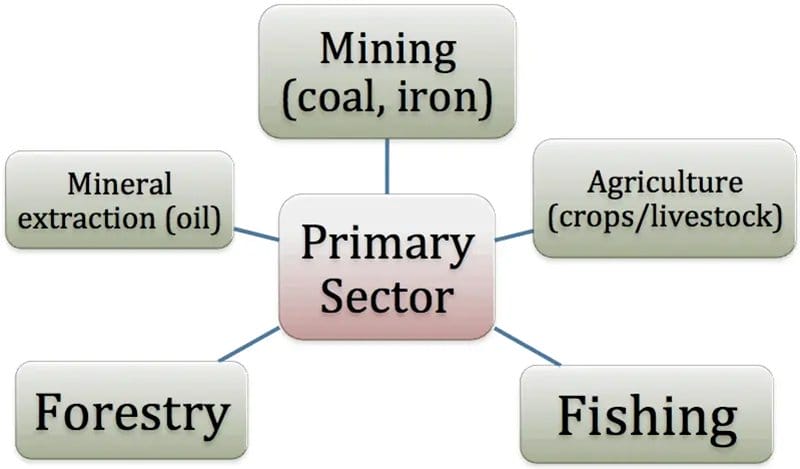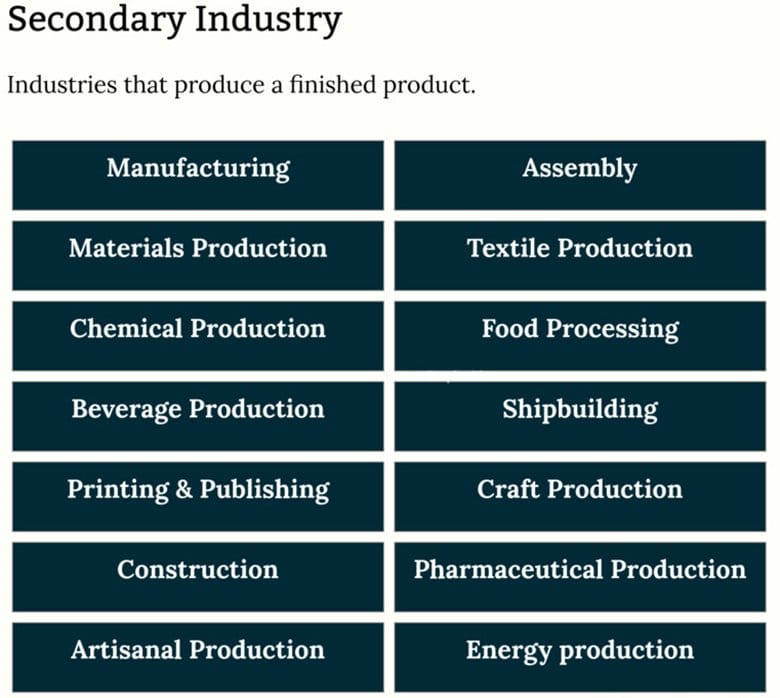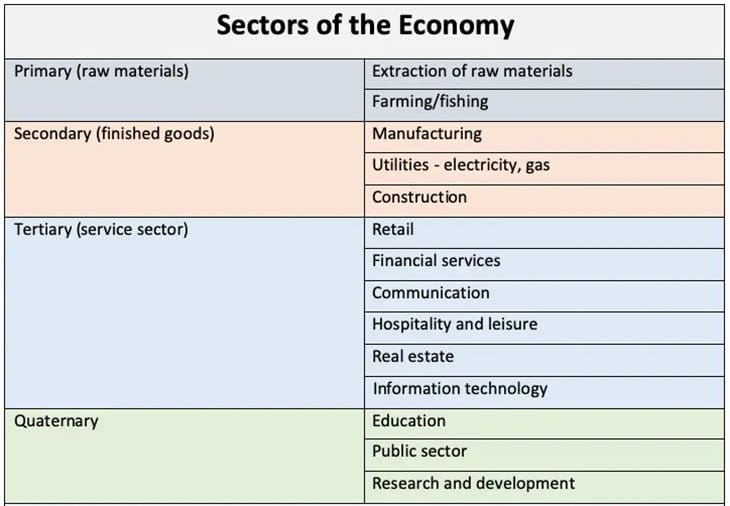Types of Industries: Primary, Secondary, and Tertiary
Industries form the backbone of the economic activities of any country. Countries rely on the solid performance of different industry sectors for potential employment opportunities and the growth of the country’s economy.
Smart countries provide a conducive environment for industries to thrive because of the strong relationship between industries and a vibrant economy.
There are different types of industries, but you can group them into three categories: primary, secondary, and tertiary.
This article explores the diverse industry types and the sub-categories under them to help you decide which industry best suits you.
Let’s get started.
1. Primary Industry
The primary industry refers to economic activities that extract natural resources and raw materials. One of the three main categories of industries, the primary sector, is specific to the environment within the particular region.
Primary industries form the backbone of the economy of developing countries. They form the basis of other sectors and a country's economy, providing needed raw materials and natural resources.
The activities associated with the primary industry link to the location's natural resources, including vegetation, water, and minerals. Red-collar jobs are the popular name for these activities, while the workforce carrying out these activities are red-collar workers.

Here are some of the activities characterized under the primary industry.
1. Agriculture
Agriculture forms the bulk of activities in the primary industry, dealing with cultivating crops and livestock for several purposes. Farmers form the bedrock of agriculture, ensuring a steady supply of the needed produce required in other sectors and industries.
The agriculture sector has different specific areas, each based on the type of products obtained. Food, textiles, raw materials, and fuel are the common sun-sector in agriculture, providing vital raw materials to other raw materials-dependent sectors.
Farm managers, agricultural nutritionists, animal nutritionists, and farm product pickers are some common careers in the agricultural sector termed red-collar jobs.
2. Aquaculture
Aquaculture is the study of organisms that live in water and is a crucial part of most riverine developing countries. Closely tied to fishing, aquaculture provides access to aquatic produce needed by food processing industries for their day-to-day activities.
The aquaculture and fishing industry is extensive in developing and some developed countries, forming a significant part of their economy. A typical example is the Scandinavian countries of Norway, Denmark, and Iceland, creating a large chunk of their GDP.
Some common careers in Aquaculture are fisherman, aquatic biologist, Aquaculture engineer, hatchery manager, and fish culturist.
3. Mining
The mining sector involves digging beneath the surface to extract raw materials. You can classify mining products as geological materials or precious minerals, including oil, metals, and coal.
Mining is an extensive process that requires converting its natural form into a mineralized form. The minerals, metals, and resources obtained from mining benefit a region’s economy, as they have a high exchangeable value.
Mining geologists, mining engineers, underground miners, and truck operators are common careers in the mining industry.
4. Forestry
Forestry is the act of planting and managing trees and forests. Forests are one of the abundant natural resources, supplying raw materials needed by various sectors and industries.
This primary sector contributes significantly to a nation’s economy, as it can form the backbone of its exports. Rubber and wood are the two main products from the forestry sector, serving as raw materials for furniture and rubber-producing industries.
Some typical careers in the forestry sector are urban forestry, forester, arborist, and forest manager.
As a country develops, there is a change from a primary-based industry to a more productive sector. This switch helps bridge the gap between developing and developed countries, making the economy more dependent on tertiary sectors.
2. Secondary Industry
Secondary industries are activities that center around adding value to natural products. This industry transforms raw materials and resources from the primary industry into valuable products in a secondary industry.
Converting these raw materials and other resources into finished products occurs through processing, manufacturing, or construction processes. These processes make up the secondary industry, ensuring a steady influx of finished products.
Sales and exports form a considerable part of what the secondary industry offers, creating value for users.
The market reacts to the influx of utility products, and the secondary sector plays a considerable role in boosting a country’s sales index through wholesale and retail trade.
Due to the concentration of machines, tools, and factories, the secondary sector accounts for significant energy usage in its day-to-day activities.
The jobs categorized under the secondary industry are blue-collar jobs, and the workers involved are blue-collar workers.

Here are some examples of the different industry sectors associated with the secondary industry.
1. Manufacturing
The manufacturing sector converts raw materials from the primary industry into finished goods. This sector provides value to consumers, making their everyday lives easier. Goods obtained from manufacturing are consumer goods or industrial goods.
Consumer goods are goods consumed directly by the end consumer, such as oil, soap, and butter. Industrial goods are designed to create consumer goods. Examples of industrial goods are machines and equipment.
Examples of careers in the manufacturing industry include manufacturing engineer, industrial engineer, welder, assembly operator, machine operator, and inventory manager.
2. Construction
The construction industry involves building, maintaining, and repairing old and existing structures. One of the critical sectors in the secondary industry is construction, which cuts across all facets of our world.
Construction companies specialize in residential, commercial, or business purposes. The manufacturing of materials falls under the scope of operation of the construction industry, converting raw materials and natural resources into functional construction materials.
Civil engineers, carpenters, masons, plumbers, and construction managers are examples of careers in the construction industry.
3. Art, Craft, and Entertainment
Art, craft, and entertainment are the backbone of the creative industry, comprising several creative individuals and organizations. The products from these creative industries are for either social or commercial purposes.
Creative industries contribute largely to the economies of first-world countries, boosting their GDP. These industries link to other essential sectors, including advertising and marketing, because of their close ties to their operations.
Movie and video production, art galleries, performing arts, and museums are examples of businesses that thrive in the creative industry. Careers you can pursue in these industries include acting, dancing, composing, and entertainment, among other creative works.
4. Fashion
The fashion industry is closely tied to the art, craft, and entertainment industries, requiring creative force. Fashion is an evolving world, and many nations are tapping into the resources this industry offers their economies.
This fashion industry provides opportunities for small and large businesses as the demand for fashion is evergreen.
Whether it is clothing designing, retail, manufacturing, or supply chain management, the fashion industry is one of the top economy earners in many developed countries.
Technological advancement favors the development of the fashion industry, with the presence of online stores making sales faster and easier.
Fashion designers, accessory designers, textile designers, and fashion wholesalers are typical examples of careers in the fashion industry.
3. Tertiary Industry
Tertiary industries involve the exchange and provision of services targeted at large-scale consumers. Often referred to as the service-oriented sector, the tertiary industry helps provide services that facilitate the smooth distribution of goods and services in the market.
The tertiary industry supports the primary secondary industries, providing services that aid their activities. For example, the tertiary sector facilitates distributing and selling goods and services to consumers across different channels.
Service delivery is the primary focus of the tertiary industry, as this industry is in direct contact with the end consumers. The tertiary sector prioritizes customer service by focusing on the people rather than the transformation into finished goods.
Activities associated with the tertiary industry revolve around public administration, transport, health, education, social assistance, and other services. Jobs related with the tertiary industry are white-collar employment, while the workers are white-collar workers.

Here are some examples of the types of areas in the tertiary sector.
1. Transportation
Transportation is one of the essential services of every economy that provides smooth movement of goods and services. This sector is vital to primary and secondary industries, providing channels for conveying raw materials and goods.
Depending on the geographical location of a place, there are different means by which goods are made accessible to consumers. The forms of transportation include road, water, air, land, and rail.
2. Accommodation and Food Services
The accommodation and food services industry is one of the critical areas of a country’s service industry. These two areas guarantee customers access to good food and hospitable places to spend for a short period.
For the accommodation services, guests can access clean and safe facilities, serving as short-term lodging options. These services usually come as hotels, guest houses, campgrounds, or motels.
Food is another essential service that is a basic necessity for human survival. Providing food services through restaurants and diners is a critical area of the tertiary industry.
Tour guides, hotel managers, restaurant managers, travel agents, and event managers are some of the common careers in the accommodation and food services industry.
3. Finance and Insurance
Banking serves as how the tertiary industry provides credit facilities to individuals and organizations. One of the crucial areas of the finance industry is banking, which helps finance industries and firms with the funds needed for their growth and survival.
Insurance provides risk coverage to the primary and secondary industries. In developed countries, finance and insurance are crucial areas of their economies, providing the means to ensure other industries perform optimally.
The finance and insurance industry activities revolve around banking, asset management, and public finance. This industry aims to ensure individuals and organizations attain their financial goals.
Some common careers in finance and insurance include financial analysts, investment bankers, financial planners, and accountants.
4. Marketing and Advertising
Marketing and advertising services help businesses create awareness about their products. The promotions done by marketing and advertising industries are either in the form of paid or organic channels.
This tertiary sector aims to present specific goods and services appealingly to consumers. Marketing directors, graphic designers, social media managers, and copywriters are examples of careers in marketing and advertising.
What Are the Differences Between Primary, Secondary & Tertiary Industries?
Primary, secondary, and tertiary industries are interdependent, representing the major business types in every economy. While each industry depends on the other, each differs in what it offers to a nation's economy.
Here are some of the key differences between the three types of industries:
1. Functionality
The primary industry supplies raw materials and natural resources for manufacturing and construction. Conversely, the secondary sector uses the raw materials the primary industry provides and converts them into valuable products and goods.
Finally, the tertiary sector uses the finished products and goods manufactured by the secondary industry through services.
2. Organization
The tertiary industry is the most organized of the three sectors as their processes are the most sophisticated. In comparison, the primary industry is the least organized as it employs conventional processes for its structure.
Secondary industry processes are more sophisticated than primary industry processes but less complex than tertiary industry ones.
3. Structure
The primary industry includes agriculture and fishing, tapping natural resources, and providing raw materials to the secondary industries.
Secondary industries mainly comprise manufacturing and construction, converting raw materials into finished and valuable goods. The tertiary sector is purely service-oriented, providing services that ensure the distribution and access to basic amenities and services.
Explore Further
- Small-Scale Industries
- Large-Scale Industries
- Best Small-Scale Business Ideas
- Most Effective Marketing Strategies
- Personal Branding
- Entrepreneur vs. Intrapreneur
- What is Customer Acquisition Costs (CAC)?
- Best Tools to Start Your Online Business